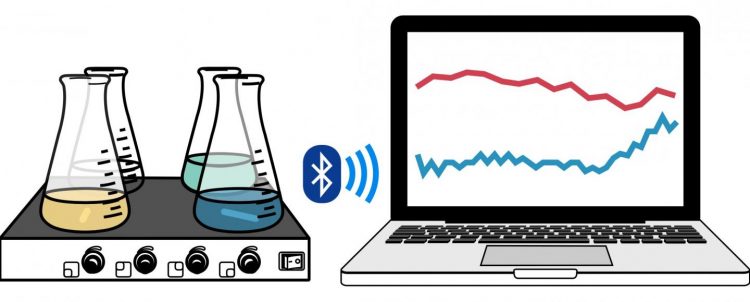Novel magnetic stirrer speaks to lab equipment

Demo of how the smart stirrer works - Cartoon version. Credit: WMG, University of Warwick Usage Restrictions: Only to be used in conjunction with this story
In the paper, 'Monitoring chemistry in situ with the Smart Stirrer –a magnetic stirrer bar with an integrated process monitoring system' published in the journal ACS Sensors, researchers from the School of Engineering, the Mathematics Institute and WMG at the University of Warwick present their innovative stirrer sensor.
The small device, called “Smart Stirrer”, performed a function of a conventional laboratory stir bar, has an integrated microprocessor and various sensors capable of wireless and autonomous report the conversion of properties of a solution. The advanced sensor stir bar is a capsule shaped magnet encased in plastic.
A beaker filled with a solution is placed on a platform that generates a rotating magnetic field, when the magnetic stirrer is placed in the solution it continuously rotates stirring the liquid.
The Smart Stirrer then monitors:
– Colour
– Transparency
– Conductivity
– Viscosity
– Temperature
Results are sent to a computer over Bluetooth, and any changes notify the user wirelessly. Although the idea of using magnetic stir bar with integrated sensors may not be entirely new, this new affordable, multi-sensor and easy programmable stirrer sensor device is first in its kind.
The concept is valuable to Research and Design laboratories and pharmaceutical and chemistry manufacturing industries because it allows wireless monitoring of several parameters of a chemical reaction simultaneously
Dr Dmitry Isakov, from WMG at the University who led the study comments:
“We are still continuing research into the stirrer, the next revision of the stirrer sensor that will be smaller size and with a bit more sophisticated sensors. We are collaborating with several chemists from Warwick University. This will help us to understand their needs and help to improve the device.
“The beauty of the Smart Stirrer is that it can be used everywhere, such as a sealed vessels thus minimising the contamination of the reactor. It may give a push to new discoveries as well. It is easy to integrate the stirrer into the labware family and make it “speak” to other lab equipment.”
Samuel Baldwin, from the Mathematics institute at the University of Warwick worked on the smart stirrer during his WMG summer internship, he comments:
“I have found every stage of development of the Smart Stirrer to be very fulfilling, from circuit design, to manufacturing to finally programming. We have leveraged state-of-the-art technology to build a device with very low power consumption, a broad range of sensor capabilities, and high data-throughput over the Bluetooth Low Energy platform.
“The laboratory of the future is that of automation, reproducibility and safety; our all-in-one Smart Stirrer device eliminates the need for a vast array of individual wired sensors whilst maintaining the control and customisability that one would expect from any piece of advanced laboratory equipment. I look forward to seeing the Smart Stirrer solve laboratory problems and help us understand complex reactions.”
###
NOTES TO EDITORS
High-res images available at:
https:/
Caption: Demo of how the Smart Stirrer works.
Credit: WMG, University of Warwick
https:/
Caption: Demo of how the smart stirrer works – Cartoon version
Credit: WMG, University of Warwick
Paper available to view at: https:/
For further information contact:
Alice Scott
Media Relations Manager – Science
University of Warwick
Tel: +44 (0) 7920 531 221
E-mail: alice.j.scott@warwick.ac.uk
Media Contact
More Information:
http://dx.doi.org/10.1021/acssensors.0c00720All latest news from the category: Physics and Astronomy
This area deals with the fundamental laws and building blocks of nature and how they interact, the properties and the behavior of matter, and research into space and time and their structures.
innovations-report provides in-depth reports and articles on subjects such as astrophysics, laser technologies, nuclear, quantum, particle and solid-state physics, nanotechnologies, planetary research and findings (Mars, Venus) and developments related to the Hubble Telescope.
Newest articles

Why getting in touch with our ‘gerbil brain’ could help machines listen better
Macquarie University researchers have debunked a 75-year-old theory about how humans determine where sounds are coming from, and it could unlock the secret to creating a next generation of more…

Attosecond core-level spectroscopy reveals real-time molecular dynamics
Chemical reactions are complex mechanisms. Many different dynamical processes are involved, affecting both the electrons and the nucleus of the present atoms. Very often the strongly coupled electron and nuclear…

Free-forming organelles help plants adapt to climate change
Scientists uncover how plants “see” shades of light, temperature. Plants’ ability to sense light and temperature, and their ability to adapt to climate change, hinges on free-forming structures in their…





















